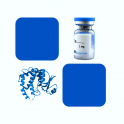
- Remove this product from my favorite's list.
- Add this product to my list of favorites.
Products
Viewed products
Newsletter
 |  |  |  |  |  |

Background
Transforming growth factor beta 1 ( TGFB1) is also known as TGF-β1, CED, DPD1, TGFB. is a polypeptide member of the transforming growth factor beta superfamily of cytokines. It is a secreted protein that performs many cellular functions, including the control of cell growth, cell proliferation, cell differentiation and apoptosis. The TGFB1 protein helps control the growth and division (proliferation) of cells, the process by which cells mature to carry out specific functions (differentiation), cell movement (motility), and the self-destruction of cells (apoptosis). The TGFB1 protein is found throughout the body and plays a role in development before birth, the formation of blood vessels, the regulation of muscle tissue and body fat development, wound healing, and immune system function. TGFB1 is particularly abundant in tissues that make up the skeleton, where it helps regulate bone growth, and in the intricate lattice that forms in the spaces between cells (the extracellular matrix). Within cells, this protein is turned off (inactive) until it receives a chemical signal to become active. TGFB1 plays an important role in controlling the immune system, and shows different activities on different types of cell, or cells at different developmental stages. Most immune cells (or leukocytes) secrete TGFB1. TGFB1 has been shown to interact with TGF beta receptor 1, LTBP1, YWHAE, EIF3I and Decorin.
Source
Recombinant Biotinylated Human LAP (TGF-beta 1), His,Avitag (LAP-H82Q6) is expressed from human 293 cells (HEK293). It contains AA Leu 30 - Arg 278 (Accession # P01137-1 (C33S)).
Predicted N-terminus: His
Molecular Characterization
This protein carries a polyhistidine tag at the N-terminus, followed by an Avi tag (Avitag™).
The protein has a calculated MW of 32.2 kDa. The protein migrates as 38-47 kDa under reducing (R) condition (SDS-PAGE) due to glycosylation.
Biotinylation
Biotinylation of this product is performed using Avitag™ technology. Briefly, the single lysine residue in the Avitag is enzymatically labeled with biotin.
Biotin:Protein Ratio
Passed as determined by the HABA assay / binding ELISA.
Endotoxin
Less than 1.0 EU per μg by the LAL method.
Purity
>90% as determined by SDS-PAGE.
Formulation
Lyophilized from 0.22 μm filtered solution in PBS, pH7.4. Normally trehalose is added as protectant before lyophilization.
Reconstitution
Please see Certificate of Analysis for specific instructions.
For best performance, we strongly recommend you to follow the reconstitution protocol provided in the CoA.
Storage
For long term storage, the product should be stored at lyophilized state at -20°C or lower.
Please avoid repeated freeze-thaw cycles.
This product is stable after storage at:
-20°C to -70°C for 12 months in lyophilized state;
-70°C for 3 months under sterile conditions after reconstitution.
Bioactivity
Please refer to product data sheet.
(1) "Analysis of LAP+ and GARP+ Treg subsets in peripheral blood of patients with neuromyelitis optica spectrum disorders"
Cai, Liu, Dong et al
Neurol Sci (2023)
(2) "Detection and Quantification of Transforming Growth Factor-β1 Produced by Murine B Cells: Pros and Cons of Different TechRhinovirus Suppresses TGF-β-GARP Presentation by Peripheral NK Cells"
Krammer, Yang, Mitländer et al
Cells (2022) 12 (1)
(3) "Effect of TGF-β1-Mediated Exercise Analgesia in Spared Nerve Injury Mice"
Sun, Wang, Wu et al
Neural Plast (2022) 2022, 7382327
Showing 1-3 of 213 papers.
Limited Use License
The Biotin AviTag technology is covered by U.S. Pat. No: 5,874,239 and includes any and all materials, methods, kits and related derivatives claimed by this patent. The purchase of the Acrobiosystems’s Avitag™ proteins confers to the purchaser the limited right to use the Avitag™ technology for non-commercial, or research use, or for purposes of evaluating the Avitag™ technology.
Commercial use of the Avitag™ technology to manufacture a commercial product, or use of the Avitag™ technology to facilitate or advance research which will be applied to the development of a commercial product requires a license from Avidity, LLC. Examples of Commercial use include, but are not limited to biosensors, diagnostics, therapeutic applications, proximity assays, and drug screening assays.
Follow us